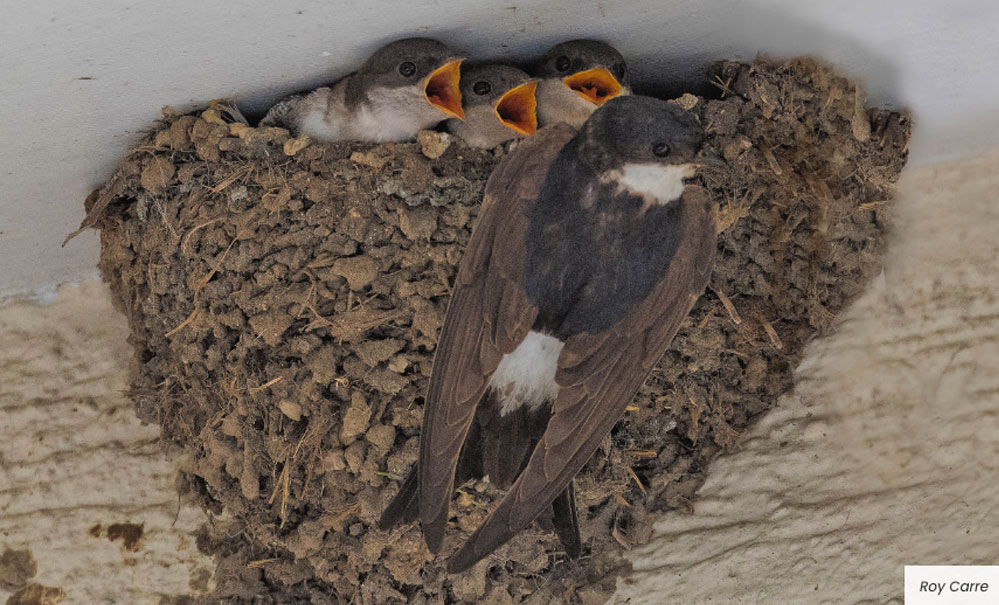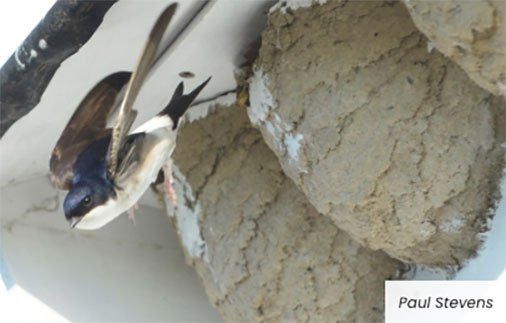House martins nest in colonies and pairs can raise two or three broods of young during the course of a breeding season which can last into September/October. There are records of young from the first brood helping to feed second brood chicks. Raising two broods will help ensure that enough juveniles survive to maintain the population, and usually occurs in old nests in good condition or artificial nests which are available when the birds return in the spring. A new nest requires time and effort to complete, it can take two weeks or more to build, which may be why newly built nests are less likely to be used for more than one brood in their first season after construction.
There are three other birds that the house martin could be confused with – the sand martin, the swallow and the swift. Watercolours below by Jonathan Pomroy.

Long before man, house martins used to breed on coastal and inland cliffs and they still do in places like North West Scotland and Malham Cove in North Yorkshire. They are semi colonial, or semi social birds as some nest collectively in groups, and others nest singly. The nesting location is critical for it has to be readily accessible and often under a roof overhang (an eave). Another habitat requirement is access to a muddy area where they can collect mud for nest building. This has to be close enough so the mud doesn’t dry in the house martins beak before being used in the building of the nest. Variables govern how many broods breeding pairs produce, anything from a single brood to three in a breeding season. Birds start to return south to Southern Spain and Africa in mid to late August and continue into September and October.
What do they like to eat?
Insects and other flying invertebrates
Measurements
Length: 12cm
Wingspan: 26-29cm
Weight: 15-23g
Population
UK breeding: 510,000 pairs
Features
Beak: black
Leg: white feathers
Feathers: black, white and blue
Where are they found?
Hamlets, villages,
countryside, wetlands
When to see them
March-Oct
See the ways you can help protect the house martin from flyers to educating your local community.
Paul Stevens is working with us to create the perfect nest forms that not only look great, but are durable too.

Our house martins (‘Delichon urbicum’) are in decline. Have you noticed your martins not returning to your house or do you remember the days when they seemed to be nesting on every other house?
So what’s going on?
Being a summer visitor to the UK and Ireland means there could be issues at home, on their wintering grounds and all those places they cross twice a year on migration. There may be several factors causing their decline, let’s take a look.
A 47% decline of house martins between 1970 and 2014 means they now have a conservation status of ‘Red’
Weather systems can affect the availability of mud and invertebrates and severe weather events may affect migration and breeding
Degradation of habitat can impact on food availability and hence survival
Suitable nest sites are in decline due to renovations and new buildings using unsuitable materials
We are familiar with the house martin as it spends time around our homes to breed finding the eaves of our buildings suitable for building their mud nests. Unfortunately the way we build our new houses and renovations to older buildings are detrimental in several ways.
1. Plastic soffits: The use of plastic soffits on new buildings or installed during renovation make it difficult for the mud nests to stick and hold. Nests fall with eggs or chicks inside that are killed by the fall or predated.
2. Modern houses: Modern houses often have no eaves or very shallow eaves which practically exclude house martins from nest building. If they do build they are often exposed to predation.
3. Intolerance: Due to the perceived ‘mess’ many colonies are under threat from home owners who just can’t tolerate droppings. Many owners of older buildings also see them as a threat to the very structure or preservation of them.
The next requirement is a suitable source of mud which needs to be, ideally within several hundred metres of the nest site, as over a thousand beak fulls are required to complete one nest cup. The mud preferably needs a high clay content which holds the nest in position for the breeding season. The better the mud, the longer the cups last, hopefully until they return the following year. So what are the issues concerning availability of mud?
1. Environmental concerns: Draining wetland areas, succession, removal or infilling of ponds and drier springs all contribute to an erratic availability of mud. No mud, no nests!
The use of an artificial nest cup is a great way to help overcome this issue and are readily used by house martins. Find out more here.
The third requirement is a plentiful food source of flying insects. This is the main reason the martins like many other migratory birds leave our shores for the winter when insects are scarce, but as the spring warms up an increase in available prey starts to appear just as the birds return. Numbers of insects then increase in abundance as the summer months pass providing food for themselves and their growing youngsters. House martins tend to nest in rural villages or smaller towns with surrounding fields of varied grasslands, woodland and wetlands. The presence of livestock is also an important factor in the availability of insects. So why have insect numbers declined?
1. Habitat loss: Habitat loss and degradation is one of the main issues where wetlands, woodlands, hedgerows and natural flowery grasslands have been removed, built on or intensively farmed. No habitat for insects, no insectivorous birds!
2. Weather: Weather may also affect the timing of invertebrate emergence and the duration for which high abundances of food are available to house martins. Both of these factors may affect the success of individual breeding attempts and whether or not a pair is able to raise two or more broods.
Weather may also affect the timing of invertebrate emergence and the duration for which high abundances of food are available to house martins. Both of these factors may affect the success of individual breeding attempts and whether or not a pair is able to raise two or more broods.
3. Pesticides: Insecticides directly affect invertebrate numbers whilst herbicides indirectly affect them by killing the plants they rely on. The decline of insects in and around intensively managed farmland is well researched, especially by Professor Dave Goulson at the University of Sussex.
House martins need to migrate due to a lack in insect prey during our winter. They head off on their migration from August- October moving slowly south often in large flocks. We are unsure of exactly where house martins overwinter in Africa but this knowledge may soon become apparent with the advancement of technology and in particularly ‘geolocators’. We do have reports of overwintering house martins on the Iberian Peninsula in Southern Europe. We are fairly certain they overwinter where there is a large concentration of aerial insects for them to feed on before returning to their breeding grounds from late March onwards.
There are two main issues they face.
Habitat loss or degradation along their migration routes can be disastrous as they need regular refuelling areas on which to stage their epic journey.
Climate change has caused the expansion of the Sahara desert making it a much longer journey with little in the way of food or water on route. The longer this takes the more likely the losses. Weather patterns have become much more erratic and extreme weather more frequent. Strong winds and heavy rain can result in bird fatalities. Drought can prevent hatches of important invertebrate food.
Why do house martins need our help? House martins are currently ‘Red’ listed as a result of a 57% decline of house martins between 1969 and 2018. The conservation status is due to be updated later this year or early next year and it is possible that the species could be changed to the higher ‘Red’ listed status. The latest monitoring results from the JNCC/BTO BirdTrends report show that house martins have declined by 75% in England from 1967-2018. These longer term results are only available for England, but shorter term results are available for all four countries of the UK from the BTO/JNCC/RSPB Breeding Bird Survey for the period 1995-2018. These show that whilst numbers are in decline over this period in England (-40%) and Wales (-19%), they have increased in Scotland (+110%) and Northern Ireland (+83%). We don’t know why there is such a discrepancy in trends but other factors are likely to be having an effect as discussed elsewhere on this website.
Whilst house martins in South East England clearly need help, the fact that we still do not know the exact reasons for the declines means that we should not be complacent about colonies in Scotland, Northern Ireland and the North of England. Prevention is better than cure and therefore any action we can take to help protect these colonies whilst they are still doing well will help to ensure that they do not experience the same dramatic declines suffered in the South East, and maintain the status of this enigmatic bird across the whole of the UK.
Sources: BirdTrends: https://app.bto.org/birdtrends/species.jsp?year=2020&s=houma BBS: https://www.bto.org/our-science/projects/bbs
If you own a home you can encourage house martins to use them to build their nests. Encourage others to do this as well. This can be done in several ways, click below to read more about what you can do.